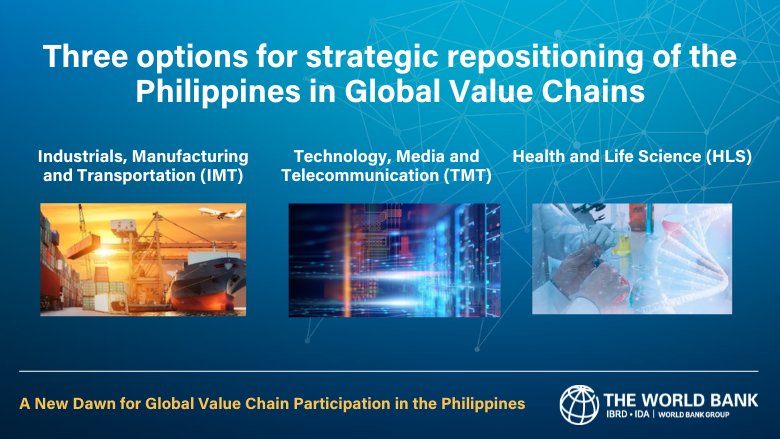
Key Findings:
- The advent of megatrends including disruptive technologies, servicification of manufacturing, and strategic adjustments in supply chains are shaping global trade and global value chains (GVCs) even before the pandemic.
- The Philippines has an opportunity to diversify into three GVC clusters that are being restructured by the COVID-19 pandemic, namely: the industrial, manufacturing, and transportation (IMT) sector; technology, media, and telecommunications (TMT) sector; and health and life sciences (HLS) sector.
- The country could benefit from the shifting dynamics of GVCs by attracting more investments and motivating operators in GVCs to develop the skills required, as investors look for alternative production sources less sensitive to trade tensions.
- The Philippines can undertake key institutional actions – in the short term, to address constraints on attracting foreign direct investments; and over the medium term, to address the country’s connectivity, energy and skills gaps.
Opportunities:
- Megatrends have the potential to change the role of low- and middle-income countries in international production networks.
- The key trend for the BPO sector is the switch from cost saving to value addition. That 82 percent of BPO centers and shared services centers in the Philippines serve global markets is a very positive attribute that targeted policies can leverage to boost the country’s participation in the TMT cluster.
- The switch from combustion engine to electric vehicles will be the main change in the automotive GVC that will provide opportunities for the Philippines to enter the electric vehicle GVC. The semiconductor industry will benefit from the recent boost in digitalization during the COVID-19 pandemic but can be vulnerable to disruptive technologies.
- The nascent state of life sciences and the biotechnology ecosystem in the Philippines is a major constraint to the growth of the biopharmaceutical sector. However, with the integration of pharmaceuticals, medical devices, and health care services and the management of information, becoming as important as the management of products, development of the IMT and TMT clusters could facilitate the emergence of an HLS cluster in the Philippines.
Strategies:
Three tactics are recommended for the redeployment of the Philippines in GVCS, namely:
- Strategic Reorientation: While the pandemic has accelerated megatrends such as digitalization, automatization and robotization, the global health crisis provides an opportunity for reorientation. For instance, the over concentration of exports in electronics and BPO services can be an opening to promote the IMT, TMT and HLS clusters that requires the coordinated mobilization of key stakeholders from government, the private sector and domestic suppliers.
- Bundling: Diversifying participation in GVCs is another key tactic, where the automotive and voice service sectors have an advantage. For instance, most automotive exports consist of electronic and electrical intermediate goods which have the potential to diversify in GVCs dealing with intermediate electronics and electrical items such as automotive, electric vehicles, aerospace and medical equipment. The voice service sector has the potential to diversify into telemedicine, pharmacovigilance, medical transcription and patient care services. On the other hand, the development of the IMT and TMT clusters could also facilitate the emergence of an HLS cluster, through electronic components and healthcare IT services, while the pharma sector promotes domestic suppliers’ networks in attracting MNCs.
- Sequencing: There are prerequisites to the successful redeployment of the Philippines in GVCs, such as the adoption of skills in the IMT sectors, the upgrading of the BPO sector particularly in the area of big data and analytics in order to achieve an integrated TMT cluster. In the life science subsector which has not yet developed in the country, telehealth and pharma MNCs are seen to be the two natural entrypoints in the HLS cluster.
Recommended Policies
- Participation in GVCs is determined by fundamentals including factor endowments, market size, geography and institutional quality. These are grouped into three categories or instruments for action: institutions, infrastructure and interventions, with corresponding recommendations for cross-cutting and institutional reforms, enhancing connectivity and upgrading strategies and incentives.
- Among many policy and institutional constraints, the report recommends addressing in the short term, boosting the country’s attractiveness to foreign direct investments and facilitating trade through the full implementation of recent key economic laws passed. It also recommends
improving access to skills and access to finance. - In the area of infrastructure, enhancing the country’s digital infrastructure should be considered a national priority. Scaling up physical connectivity is also seen to boost export growth in regional hubs. These efforts should be complemented by the development of advanced logistics and ICT services, with full implementation of the Customs Modernization and Tariff Act, coupled with comprehensive financing strategy to maximize the successful implementation of these initiatives.
- The report also provides direction on targeted infrastructure and service provision in special economic zones, along with upgrading, to help foster participation in the IMT, TMT and HLS clusters. Clear identification of sectors and prioritization in the government’s investment priority plan is key, along with securing access to affordable energy in SEZs. The report recommends promoting the development of green energy, where subsidies and other incentives could be used to crowd in private investment in renewables and promote clean and affordable energy.